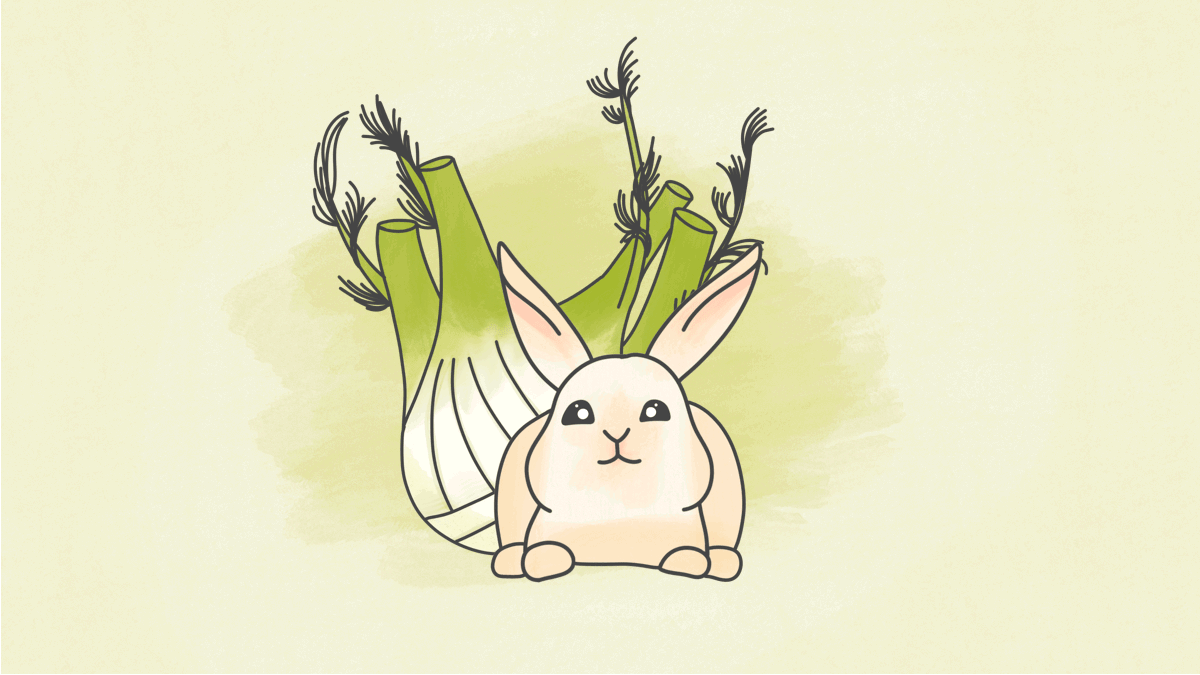Savoirs
Fennels for Rabbits

Fennels for Rabbits
Oh, that pretty bulb with the aniseed flavor doesn’t leave you indifferent? It’s a safe bet to say that it is the same for your little companion 🐰
But do you know where it comes from, how much and how often to feed it to your rabbit, or how you might eat it yourself? No ? Well, follow the guide 👇
In practice
Fennel is rich in fiber, potassium and beta-carotene (precursor of vitamin A), it is moderately rich in calcium and low in calories, it also has diuretic and galactogenic (= that promotes lactation) properties and it improves digestion by reducing gas production and promoting the digestive system. In other words, it has lot of qualities! 🙂
Your rabbits can take advantage of these qualities without moderation, or almost: you can thus offer them every day, at a rate of 40g (i.e. ¼ of fennel) over the day.
Bulb, stalks, leaves, and even roots can be offered (although it is difficult to find anything other than the bulb in the shops. See at farmers markets, some will gladly provide the whole plant).
Origin
Native to the Mediterranean basin, the first descriptions of it can be found as early as antiquity in Greece, Macedonia, Egypt and Turkey, as well as in China (although it must be admitted that the latter is still a bit far from the Mediterranean basin 😏). It was then consumed as a condiment, and for its medicinal virtues.
The Romans, after the conquest of Greece, took with them the seeds of this vegetable that they sow (sometimes in spite of them) until Great Britain, according to the advances of their army.
Until the 19th century, it was cultivated only for its stems and leaves; the bulb was hardly used.
One lends to it many virtues over the centuries: it would thus support the lactation of the young moms, would relieve the stomachaches of infants, would cure poisonings, and would even push back the demons, the witches and bad spirits! (Now that’s some serious plant stuff! 💪)
Gardening/where to get it
To grow, fennel needs warmth, sunlight, and well-drained soil. You can grow it in a pot indoors or on a south-facing terrace, but be aware that when fully grown, fennel can grow from 1,50m to 2,50m tall!
For those who have a garden, choose a sunny spot, and sow 3-4 seeds every 45 cm after the last frost. After emergence, keep only the strongest of the plants and water them every week or so (depending on the rainfall in your area). Although it likes well-drained soil, fennel also likes cool (i.e. moist) soil.
After a few months, you can harvest the bulb, stems and leaves to enjoy with your beloved rabbit. And if you don’t have the patience to wait, feel free to cut a few leaves from time to time as it grows 😉
Preservation
You can simply store them in your refrigerator crisper for about a week.
If you want to store them longer, and if you have the opportunity, arrange them in crates filled with sand (without the bulbs touching).
Recipe for Humans
Roasted, braised, sautéed… You’re probably familiar with cooked fennel, often with a little sugar to break up its bitterness. But do you know the lighter flavor of raw fennel? Crunchy and refreshing, this recipe should reconcile you with this bulb with a thousand virtues!
Servings: 2
- 1 fennel bulb
- 1 log of goat cheese (or vegetarian cheese)
- Some hazelnuts (about 40g)
- 1 tablespoon sherry vinegar
- 1 tablespoon of honey
- 2 tablespoons hazelnut oil
- 2 tablespoons neutral oil
Start by thinly slicing the fennel bulb, using a mandolin for example.
Mix together the oils, vinegar and honey.
Add a few pieces of goat log or vegetarian cheese, and the crushed hazelnuts to the fennel, then serve with the vinaigrette. And yes, it’s that simple 😉 Bon appétit!

 Food
Food Essentials
Essentials Toys
Toys Accessories
Accessories Goodies
Goodies

